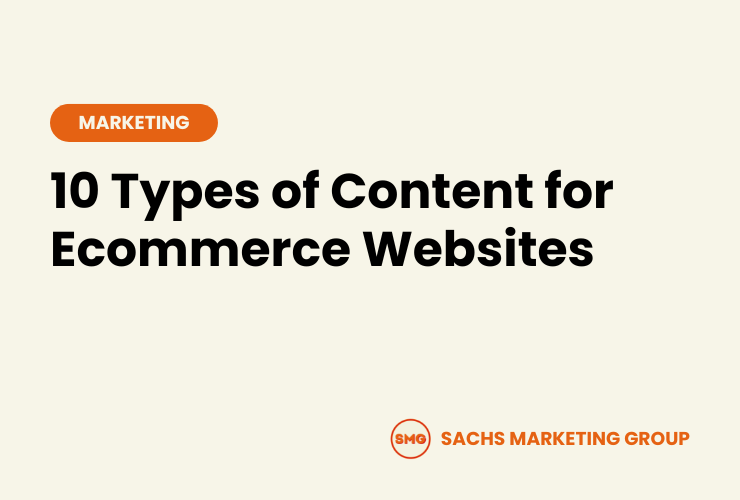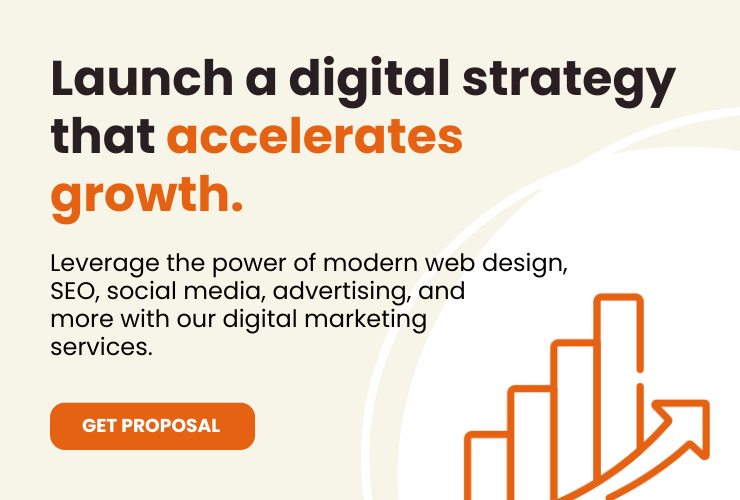There are different types of content uniquely suited for ecommerce websites, each designed to engage shoppers at various stages of their journey. From detailed product descriptions and informative blog articles to engaging videos and user-generated reviews, these content forms work together to build trust, answer questions, and provide a rich online shopping experience, ultimately encouraging sales and customer loyalty.
For ecommerce websites, content is the engine of customer engagement and conversion. It’s not just about describing your products – it’s about telling a story that resonates with your customers, addresses their needs, and presents your offerings as the solution.
From product descriptions to engaging visuals, the content on your ecommerce site serves multiple vital functions, including driving traffic, educating buyers, and influencing purchase decisions.
We’ve shared some tips about ecommerce SEO and ecommerce website design, so we thought we might share some tips about content for ecommerce sites. In this article, you will discover everything you need to know about content for ecommerce websites.
Overview
Types of Content for Ecommerce Websites
Content for ecommerce websites can include a range of formats, each serving a distinct purpose in attracting, engaging, and converting visitors into loyal customers. It’s a blend of information, persuasion, and entertainment crafted to provide value at every touchpoint in the customer journey.
Here are 10 types of content for ecommerce websites:
1. Product Descriptions
Product descriptions are more than just factual statements about what you’re selling – they’re opportunities to persuade and inform potential buyers.
A compelling product description combines essential details with enticing language that highlights the benefits and unique selling points of the item. It should answer any questions a customer might have and preemptively address potential objections.
Descriptions must be SEO-friendly, incorporating keywords naturally to improve search engine rankings. They should also adapt to the customer’s perspective, using language and terms familiar to them.
For example, a description for a high-end camera would not only list megapixels and sensor types but also explain how these features translate into better photos in everyday use.
2. Blog Posts
Blog posts serve as a versatile content medium for ecommerce sites, helping to drive traffic, establish brand authority, and connect with customers on a deeper level.
They can cover a wide range of topics, from how-to guides and industry news to behind-the-scenes insights and storytelling that relate to the products you sell. Blogs are an excellent way to incorporate a mix of long-tail keywords that might not fit naturally on product pages, enhancing your SEO efforts.
For instance, an ecommerce site selling kitchenware might feature blog posts with recipes that recommend and link to their cooking tools, providing value to readers while also promoting their products.
Check out our guide How to Develop a Blog Content Strategy to learn more and get started!
3. Comparison Articles
Comparison articles are a crucial content type for ecommerce websites, particularly in markets with numerous similar products.
By directly comparing features, prices, and benefits, these articles help customers make informed decisions. They not only serve as a valuable resource for shoppers but also improve your site’s credibility and authority.
SEO can be enhanced through the use of specific keywords related to the products being compared. For example, a tech ecommerce site might have a comparison article on the latest smartphones, offering a clear, side-by-side comparison of features, performance, and value, enabling customers to choose the phone that best suits their needs and budget.
4. Buyer Guides
Buyer guides are an essential tool in the ecommerce content arsenal, providing a pathway for customers to navigate through the often-overwhelming sea of options.
These guides are designed to educate and direct consumers toward the best products for their specific needs, thereby simplifying the decision-making process. A well-crafted buyer guide not only demonstrates expertise and builds trust but also subtly steers customers towards making a purchase.
It should be comprehensive, addressing different use cases and preferences, and be rich in keywords to attract organic traffic.
For instance, a buyer guide for outdoor gear could help customers choose between products based on seasonality, activity type, and expertise level, while reinforcing why your ecommerce platform is the optimal choice for their purchases.
5. User-Generated Reviews
User-generated reviews are the lifeblood of authenticity for ecommerce websites, offering unfiltered insights into customer satisfaction and product performance.
These reviews harness the persuasive power of social proof, where potential buyers feel more confident in their purchasing decisions when they see honest feedback from their peers. Reviews should be easy for customers to submit and for prospects to navigate, ideally featuring a rating system and the ability to sort by relevance or helpfulness.
For SEO purposes, reviews can also contribute fresh, keyword-rich content to your product pages.
A good example is allowing reviews on a book-selling website, where readers can share their experiences, thus helping fellow book enthusiasts make well-informed decisions.
6. Frequently Asked Questions
Frequently asked questions (FAQs) provide immediate answers to common customer inquiries, easing the purchasing process by eliminating doubts and uncertainties.
This section is a strategic content feature that can save time for both customers and customer service teams. Well-organized FAQs that cover product features, shipping policies, return procedures, and other operational details can significantly enhance the user experience.
Moreover, FAQs can be optimized for search engines, incorporating questions that customers are likely to type into search engines, thus improving the visibility of your ecommerce site.
For example, a fashion ecommerce site might include questions about size guides, material care, and return policies, offering concise and helpful information that enhances customer satisfaction and SEO.
7. Video Demonstrations
Video demonstrations are a dynamic and engaging way to showcase products on ecommerce sites. According to Demandsafe, 73% of people prefer watching a short-form video to reading an article when learning about a product.
They provide a realistic view of the product in action, helping customers better understand the item and reducing the ambiguity that sometimes comes with online shopping.
These demonstrations can highlight product features, show different uses, and even compare products in a visually rich format that text and images alone cannot match. Videos are also highly sharable and can significantly increase the time spent on your product pages, which can positively impact your site’s search engine rankings.
For instance, a video demonstration on an electronics ecommerce site could show the setup process for a new gadget, highlighting ease of use and functionality, while also including key phrases and terms for SEO.
8. Interactive Content
Interactive content such as virtual tours and 360-degree product views is revolutionizing the ecommerce experience, offering customers a closer look at products from the comfort of their homes.
This type of content can significantly increase engagement by enabling customers to interact with products online in a way that mimics the in-store experience. Virtual tours of spaces or product setups provide an immersive experience, often leading to increased confidence in the purchase decision.
For example, an ecommerce site specializing in home decor could offer virtual room tours where customers can see how different furniture pieces look in a simulated home environment.
Interactive content like this not only serves to inform and entertain but also boosts the site’s dwell time and engagement metrics, which are positive signals for SEO.
9. Infographics
Infographics are a visually appealing way to distill complex information into an easy-to-understand and shareable format.
They combine text, images, and design to tell a story or explain data, making them particularly effective for ecommerce sites that need to convey product benefits, industry statistics, or how-to guides succinctly. For SEO, infographics can generate backlinks as they are shared across the web, thus driving traffic back to your site.
An ecommerce site selling fitness equipment, for example, could use an infographic to illustrate the health benefits of regular exercise using their products, providing valuable content that customers are likely to share.
10. Interviews and Expert Opinions
Featuring interviews and expert opinions on your ecommerce site adds a layer of authority and credibility to your content.
This type of content can position your site as a thought leader in your industry, building trust with your audience. Experts can offer insights on product usage, and trends, or provide tips that relate to the products you sell.
The fresh and unique content provided through interviews can boost your site’s relevance for specific topics or keywords. A skincare ecommerce website, for instance, could feature interviews with dermatologists discussing the science behind their products, which not only educates the audience but also enhances the site’s authority in the skincare industry.
How to Develop Your Ecommerce Content Strategy
Developing an ecommerce content strategy requires thoughtful planning and a clear understanding of your brand’s goals and your audience’s needs. Here are six essential steps to build an effective content strategy for your ecommerce site:
- Define Your Content Goals: Align your content objectives with your business goals. Whether it’s driving sales, increasing brand awareness, or educating customers about your products, having clear goals will shape the direction of your content strategy.
- Understand Your Audience: Conduct market research to understand who your customers are, what they need, and what kind of content will resonate with them. Creating buyer personas can help tailor your content to different segments of your audience.
- Audit Your Current Content: Review the existing content on your site to determine what’s working and what’s not. Look for gaps in your content that need to be filled to meet your audience’s needs and your business goals.
- Plan Your Content Types: Based on your goals and audience research, decide on the types of content you will create. This could include product descriptions, blog posts, buying guides, videos, infographics, and more.
- Analyze and Revise: Use analytics tools to monitor how your content is performing. Look at metrics like page views, time on page, bounce rate, and conversion rate to understand user behavior. Revise your content as needed based on these insights to improve engagement and achieve better results.
- Hire a Digital Marketing Agency for Help: Consider bringing in a digital marketing agency that offers content development to refine your approach. A strategist can provide expertise in SEO, copywriting, and content marketing to elevate your strategy and ensure that your content meets both user and business needs effectively.
Need Help Creating Content for Your Ecommerce Website?
Crafting compelling content for an ecommerce website can be a complex undertaking. Sachs Marketing Group is here to help!
Sachs Marketing Group brings years of experience and a creative edge to the table, ensuring your content is not only seen but also resonates with your audience. Let our full-service digital marketing team elevate your ecommerce content and help you stand out in the digital marketplace.
Contact Sachs Marketing Group today and schedule a call to discuss your ecommerce website and possible content strategies.
Conclusion
Quality content is the cornerstone of a successful ecommerce website. It educates, entertains, and engages customers, guiding them through the purchasing process and beyond.
With the right approach and expertise, your content can transform your ecommerce site into a dynamic, sales-generating platform.
Have questions? Let us know in the comments section below.
Contact us today to get the conversation started!












